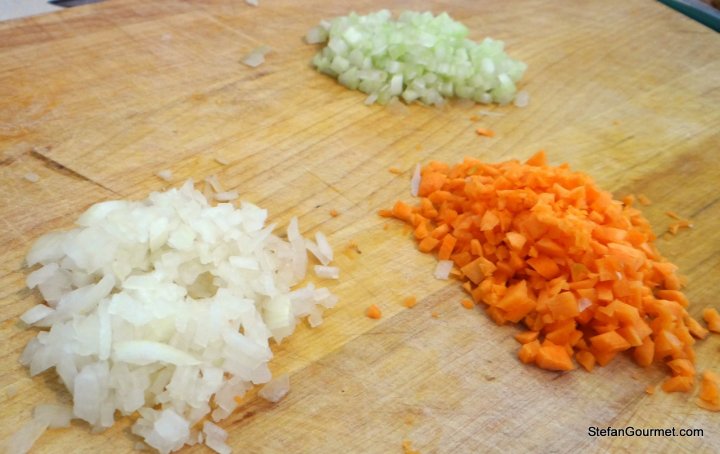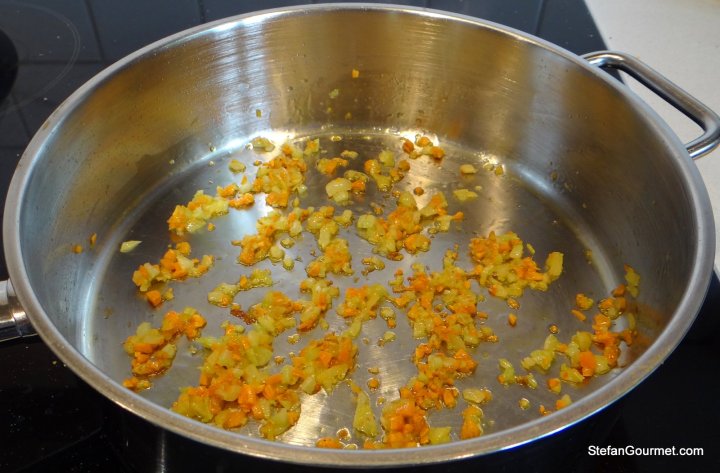Without a doubt, the regional snacks of Sicily are arancine or arancini. These are deep-fried balls of rice, stuffed most often with a ragù (meat sauce) and peas, but also with other stuffings such as cheese. Arancini are everywhere in Sicily, and we liked them so much that we had them for lunch almost every day during our trip.

Arancini have been named after oranges (arancie), because they look so much like them. In the West of Sicily they have a round shape and are female (1 arancina, 2 arancine), whereas in the East of Sicily they are pear-shaped and are male (1 arancino, 2 arancini). This could mean that the eastern name is more ‘Sicilian’, because oranges are male in Sicilian (arànciu) contrary to female in Italian (arancia). I entitled this post arancine because I made round ones, but I like the sound of arancini better so that’s how I’ll call them.

After coming home, arancini were high on my list of Sicilian delicacies to prepare. They turned out to be relatively easy to make and very good. When we had arancini for lunch in Sicily, they had been lying in a display case for a while and were heated up in a microwave oven. This has an advantage that the flavors have the opportunity to blend, but the crust is not crispy. My homemade arancini were freshly deep-fried and thus very crispy. Next time I’ll make them earlier to allow the flavors to blend before deep-frying them. But even deep-fried straight away they were delicious!
Ingredients
200 grams (1 cup) rice (I used risotto rice, it should be sticky rice)
40 grams (1 1/2 oz) freshly grated pecorino (or parmigiano)
12 grams butter (1 Tbsp)
0.05 grams of powdered saffron
200 grams (7 oz) ground beef
160 ml (2/3 cup) beef stock
70 grams (5 Tbsp) single-concentrated tomato paste
80 ml (1/3 cup) full-bodied red wine
1 Tbsp olive oil
20 grams (1 small) onion
20 grams (1 small) carrot
20 grams (1/2 stick) celery
80 grams (1/2 cup) frozen peas
salt and freshly ground black pepper
2 eggs
breadcrumbs
vegetable oil for deep frying
Preparation

Put the rice in a pot. Add just enough water to cook the rice, such that you won’t have to discard any starchy cooking water. This is about 480 ml (2 cups).

Cover the pot, bring to a boil, then lower the heat, and boil until the rice is cooked, about 10 minutes. If there is still too much water towards the end of the cooking time, remove the cover for the final minutes of cooking.

All the water should be absorbed and the rice should be very sticky.

Combine one egg yolk (reserving the egg white) with the powdered saffron, and stir to mix.

Add the egg yolk with saffron to the rice.

Stir until the color is evenly yellow.

Add the butter and grated cheese, and stir to mix.

Taste the rice and adjust the seasoning with salt. The rice should be slightly more salty than you think it needs to be, as is always the case when making a filling.

Spread out the rice on a wide plate and allow it to cool to room temperature, at least an hour.

Meanwhile, prepare the ragù. Chop the onion, celery, and carrot very fine. (You could also use a food processor for this.)

Add the tomato paste to the beef stock and stir to mix.

Heat the olive oil in a frying pan and sauté the onion, celery, and carrot over low heat until soft and slightly golden, about 10 minutes.

Increase the heat, add the ground beef, and brown it. Add a bit more oil if needed. Use wooden spatulas to break up the meat.

Once the meat is brown, add the red wine and allow most of it to evaporate.

Add the tomato paste diluted in beef stock.

Bring to a boil, then lower the heat to a mere simmer.

Simmer, uncovered, until the ragù is very thick, about 1 hour. Taste and adjust the seasoning with salt and freshly ground black pepper. Again, the ragù should be slightly more salty than you think it needs to be.

Add the peas and cook until they are cooked but still crunchy (a few minutes). Turn off the heat.

To make an arancino, take enough rice to fill the palm of your hand with a thin layer (less than 1 cm, about 1/3 inch). If you wet your hands with cold water, the rice won’t stick as much.

Add about two tablespoons of ragù.

Shape the rice around the ragù.

Cover the arancino with some more rice, shaping it with your hands. Repeat until you have used up the rice and the ragù. You should have enough rice and ragù to make 6 arancini.

Set up an ‘assembly line’. Put the reserved egg white with the remaining egg in the first deep plate and beat with a fork until the egg has loosened. Put breadcrumbs on the second plate.
Dip each arancino first in the beaten eggs and then in the breadcrumbs, making sure that they are covered completely with both of them.

Arrange the finished arancini on a plate, turning them around after a while to let the underside dry as well. You can store them like this in the refrigerator for a while to allow the flavors to blend, or deep fry them right away.

Deep fry the arancini in hot vegetable oil.

The oil should be 180C/350F. Do not add too many arancini at the same time, otherwise the temperature of the oil will drop too quickly.

Remove the arancini from the oil with a slotted spoon as soon as they are golden. Now you can see the resemblance with an orange.

Allow them to drain on kitchen paper to get rid of excess oil.

Serve warm, although they are also good at room temperature.



Those look really great. When cooked at the right temperature and with good oil, deep-fried foods are wonderfully delicious and not greasy at all. It’s funny because yesterday at work my colleagues and I were talking about your country’s New Year’s doughnuts, oliebollen, which I love as well.
LikeLike
Thanks, Clayton. I like oliebollen most when they come just out of the oil and are still crispy.
LikeLike
Delicious! 🙂
LikeLike
Grazie 🙂
LikeLike
I finally bought a small deep fryer and still haven’t used it. I think I was waiting for this recipe! Thank you!
LikeLike
You’re welcome 🙂 I’m sure you’ll like them
LikeLike
One of my favourite things ever. Sometimes I used to ditch school and go to Bologna’s center of town, to the only rosticceria where they made arancini and I would treat myself to one. A proposito, in italiano corretto arancio e’ l’albero e arancia la frutta. Quindi, si dovrebbero chiamare arancine pero’ anch’io li chiamo arancini. Vagaries of the language!
LikeLike
Thanks for sharing such a nice image of your childhood 🙂 Do you still make them? It’s interesting how the sex of words changes between languages, apparently even between Sicilian and Italian.
LikeLike
I make them from time to time, as my mother used to make them too. Mine don’t have ragu’ inside but mozzarella, prosciutto cotto and peas. They are more Roman style
LikeLike
Nice 🙂
LikeLike
looks really great
LikeLike
Thanks 🙂
LikeLike
These look fantastic and I really like your instructional photographs. Thank you.
LikeLike
You’re welcome, thanks for leaving such a nice comment 🙂
LikeLike
These look really good. Now, I’m hungry. 😦
LikeLike
🙂
LikeLike
These look fantastic, Stefan, and very similar to those I had while in Sicily. Interesting that there was a benefit to leaving them to sit for a day, rather than eat them freshly fried. Even so, that photo where you’ve split one in half sure looks delicious!
LikeLike
Thanks, John. There is also something about eating them on the square of a town in Sicily overlooking the duomo 🙂
LikeLike
Reblogged this on etnicole.
LikeLike